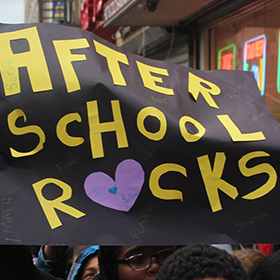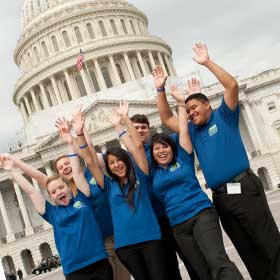Know the facts
We want the public to know why afterschool matters, and candidates to know that supporting afterschool is important to voters.
-
The parents of nearly 25 million children would send their child to an afterschool program—if one were available.
-
We can’t afford not to invest in afterschool programs.
-
Voters want government at every level to invest in afterschool.
-
9 in 10 Americans think afterschool programs are important.
-
8 in 10 parents (83 percent) support public funding for afterschool programs and want to see all levels of government to commit funding.
-
Parents of nearly 25 million children say they would enroll their children in an afterschool program if one were available to them.
-
Voters say they are willing to use taxpayer money—and even pay more in taxes—to support afterschool programs.
-
For more information on voter attitudes, look at the polling data section of the Afterschool Alliance website.
-
Dozens of formal studies clearly demonstrate the effectiveness and impact of afterschool programs.
-
Example No. 1: Elementary school students attending LA’s BEST afterschool program improved their regular school day attendance and reported higher aspirations regarding finishing school and going to college. Participants were also 20 percent less likely to drop out of school compared to matched nonparticipants.
-
Example No. 2: High school students participating in Chicago's After School Matters program have higher class attendance, lower course failures and higher graduation rates than similar students who do not participate in the program.
-
For more information go to the Facts & Research section of our website.
-
Unfortunately, adequate childcare is not always available in every community.
-
Nationwide, nearly 5 million children in grades K-8 regularly care for themselves.
-
Today, less than one-fourth of American families fit the “traditional” image of one parent at home caring for children full time, while the other parent provides financial support. In fact, 77 percent of mothers with school-age children are employed.
-
The gap between work and school schedules can amount to as much as 25 hours per week.
The bottom line is this: afterschool programs keep kids safe, inspire them to learn and help America’s working families. The realities of today’s working world make afterschool programs an absolute necessity.
Familiarize yourself with the impact of afterschool policy
Afterschool funding and policy affects millions of children and families. Federal policy initiatives that have a major impact on afterschool include:
For information on how to reach the audiences that matter most to your campaign, check out our Key audiences and Easy outreach strategies pages.
Resources
Making your voices heard at key moments is critical! Take a look at how a bill becomes a law to see where the key decision points fall in the federal policy making process.
For background on how state budgets are created, go to our State Policy Center.
For more ideas on how to take action, and key advocacy dates for this year, visit our Take Action Center.
The Candidate’s Guide to Afterschool provides a primer on afterschool issues for candidates.
Gather signatures on the downloadable Afterschool for All Community Petition.












